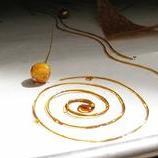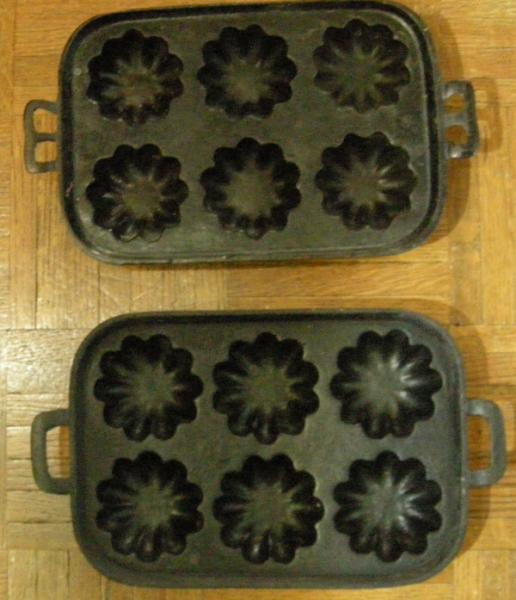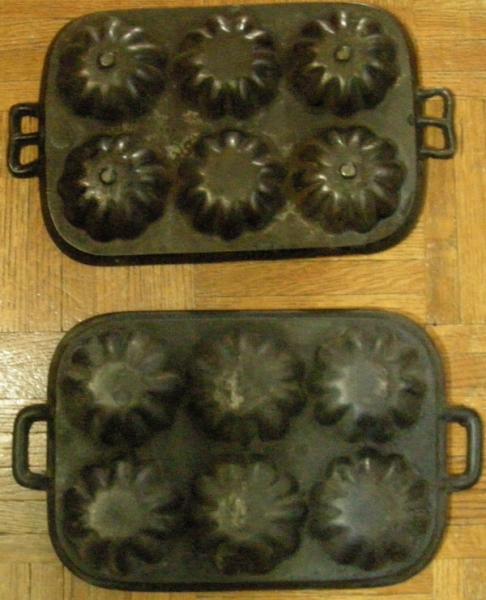-
Posts
3,934 -
Joined
-
Last visited
Content Type
Profiles
Forums
Store
Help Articles
Everything posted by Lisa Shock
-
I have never shocked my pan...I would fear that such an action would cut down on the pouring time which is small enough. Why and how do you use this method? Thanks. I am always interested in ways to extend the liquidity of the candy mass if possible to pour into the molds. I was taught this way at the Cordon Bleu, so, I've always just done it. Basically, once the sugar gets to temperature I take the pot off the flame and place it on ice for about ten seconds. This prevents the carryover cooking from getting too extreme and possibly caramelizing (if you want clear) or burning (if you want caramel) the sugar. To keep pour-ability, I have the luxury of a heat lamp and torch. Once the sugar has been boiled, you can always re-heat it briefly on the stove or in a microwave, if it's too thick to pour.
-
I also use canning jars, and I have the jar sealer attachments for my FoodSaver, so I can vacuum seal everything.
-
A thermometer and good, even-heating pan are essential for consistent results. I find hot pads to protect the hands while moving the pot around to be essential. You'll need plenty of ice and a big bowl to shock your pan in, and to be prepared to ice down accidents. Molds and a couple of silpats are also very useful. Just in case, I would try to make these while someone else is home, just in case a terrible accident happens and you need to go to the emergency room.
-
They announced their initial programming lineup today.
-
I always temper, just in case. But, then, it gets pretty hot here and things can go out of temper in storage pretty easily. Some of these products are shipped in a tempered state, and, a low temp direct melt will preserve that temper. Some people rely on that to work. I don't trust it, been burned, never again. If you are using tiny amounts for, say, painting colored decor into chocolate molds, you can spot temper on a table or palette.
-
I tend to peel only for soups and sauces. I seed for certain salads and salsas if the water would be too great. I find that in some salads, the water makes a good salad dressing component if you balance the seasoning appropriately.
-
I am so jealous of those ovens! My personal preference in refrigerators is freezer on the bottom. You use the freezer less often, so, it makes sense to me to have the fresh food easiest to reach. I hate bending over for the crisper.
-
I'd say it's a sauce. It's not a beverage because a beverage is served in a glass or cup. A beverage is never served in a bowl. (consomme may be sipped from a consomme cup, but, it's not a beverage)You wouldn't call the cream poured over sliced peaches a beverage. There's also the issue that the cereal is the main item being served. Anything else is ancillary. This includes sliced fruit, nuts and sweeteners. It's not a broth because broths are man-made infusions of herbs, meat and/or bones.
-
Hey, those older Crock-Pot units are highly prized because the low temp settings on them is lower than on modern ones, making slow-cooked beans, etc., much, much better. The newer units reflect worries about food safety at low temps and simply can't perfom in the same way. You have a treasure.
-
Has anyone made regular, old fashioned, oatmeal (not steel cut) in a rice cooker then used it to hold during restaurant service? I'm trying to set up something for a small place that wants to be able to serve about 15 portions of oatmeal over a 3 hour time period without it becoming a solid lump.
-
Don't forget to use a short-grain rice, not a long-grain one. Short-grain rices are tender when cold, long-grain ones will be hard due to having more amylose -it crystalizes when cold.
-
For a starch, I like to make jasmine rice or Israeli cous-cous. I add a LOT of minced fresh herbs (parsley mostly) at the start (a big handful for every cup of dry grain) so that when it cooks you get an attractive, very green starch dish. People think it's healthier, and it looks better than plain beige rice or cous-cous. For a fancy starch, I'd go with peas pulao - sort of India's answer to fried rice. I'd like to point out that panna cotta is easy to make, so, if you can store it cold, making a lot of flavors is easy. Will you have servers? If so, a sorbet would be nice.
-
Since this is a day for the ladies, I'd emphasize pretty food that is light. On the desserts, I'd set a limit of maybe 5 different items. People tend to want to try one of everything, so if you have 5 items (2 different cookies, panna cotta, brownies and tarts maybe) you'll need 750 pcs. (plus extra for loss) If you make ten different items, you'll need 1500 pcs. Quiche can be made in advance and served cold. Each 8" pie can be cut into 8-10 slices, meaning you'll need to make 20 or so. You can get very creative with fillings without breaking the bank. It's traditionally served with salad as the side. You can make large batches of cream biscuits and offer them as plain, or, flavored versions with shredded parmesean or other cheeses, cayenne pepper, herbs, etc. I have made a good casserole-type dish that I call Green Beans Primavera -an improved, made from scratch, green bean casserole. Blanch lots of fresh green beans along with julienned carrot, red pearl onion, julienned bell peppers of various colors and anything else you can get ahold of. Mix in a hotel pan with alfredo or primavera sauce and add some frozen peas, and maybe snow peas. Top with breadcrumbs mixed with parmesean. Heat and serve, holds well in a chafer. New potatoes are in season now, a simple dish of parsleyed potatoes and fresh butter might be nice -you could add baby carrots for color. I also like beurre noisette over otherwise plain steamed potatoes and carrots. A fruit salad made with berries would be nice. Panna Cotta can be made two days in advance, there are some great fruit flavors possible. My favorite is to simply infuse some orange peels as the cream is heated, and use vanilla bean. But a berry flavor might be more colorful. I make these up in 5.5oz plastic wine cups from the party supply store. Cookies can be made in advance and held, even dough could be made now and frozen til needed. Another easy dessert is to buy or make chocolate cups, pipe in pastry cream and top with fruit. Hope this helps!
-
Thanks so much! That pan on Amazon will be great, especially since I occasionally cook for a supper club and have to carry my stuff with me to cook in strange kitchens-I'm afraid of losing my antique cast iron at a party.
-
Maybe, but, you'd still be stuck with the problem of enzymatic browning resulting in a fairly dark, probably unsightly, end product. I'd try making a banana puree with a little vitamin C powder before infusing.
-
Are you serving bread baskets before dinner, making sandwiches, or what? There are a lot of types of bread, most have very inexpensive ingredients. The main cost is labor. We can guide you, but need to know how it will be used to be able to give suggestions.
-
I love your pans and they are 19th century, but they are actually called "turk's head" pans as "gem" pans are smooth with no scallops (and are actually more common in the early days). Pans like yours were harder to cast well so they are rarer - they are sand cast and required a good deal of hand finishing after casting and those scallops made it more time consuming. Gem pans are either half a globe rounds or shallow ovals with a slightly flattened bottom. Like these... The "golfball" name they use is very recent and seldom used by serious cast iron collectors. Here's another site that has gotten a fair amount of my money in recent years but not for cast iron pans, I inherited those but they have some wonderful figured molds. antique molds and pans I have a couple of the turk's head pans that hold a dozen muffins one is made by Griswold and the other by the Chattanooga Foundry and it is quite rare. The early muffin pans did not have to be used exclusively in an oven but could be placed on a tall trivet in front of or at one side of the kitchen fireplace and thus bake the muffins. I used to take mine on camping trips many, many years ago, and baked plenty of corn muffins with a reflector oven and a wood fire. Thanks! I had always figured the 'turk's heads' were pans where the grooves came down at an angle, like babba molds. But, hey, live and learn! I really like these pans and wish that a modern manufacturer made them. When I was a kid I had a toy set of pans that had a mini version in aluminum, and I baked all sorts of treats in it. So, as an adult I went looking for a similar pan and wound up having to buy them at antique stores. Someplace, I also have one that makes mini, two-bite sized treats.
-
You might want to look at various toolboxes at the hardware store. I have a high-impact plastic Black & Decker tool box on wheels for my pastry equipment, I got the long one because I have rolling pins. The make smaller versions and, other companies make other configurations. You can always add dividers, or place padded bags inside.
-
I have these two cast iron gem pans, the top one is marked with the letter 'R' and the bottom one is completely unmarked. The bottom one has gate marks on the middle two cups (on the underside) while the top one as sprue nubs on the outer four cups. As far as I know, this means that these are from the 19th century. While cast iron made this was was popular in the 1700's, the small size of these pans means they were probably for use in a home of modest means, and people didn't have ovens in their houses until stoves became popular in the mid-1800's. An older item would have been used by a professional bakery, and probably larger, with more cups. Anyway, I love these! I love making brownies in them, since everyone in my house is a 'corner lover' and this means that everyone gets lots of chewy crispy edge. Cornbread is also wonderful from these, and very attractive to serve to company.
-
Blackened redfish was huge in the 80's, but, I know that population is in decline, so I cannot recommend it. Santa Fe 'style' was hot and southwestern food became trendy -fresh salsa was introduced to supermarkets all over. Tahitian vanilla was everywhere in desserts in the 80's, and gourmet pizza with anything on it was being copied by a lot of people. For me, home cooking was epitomized by The Silver Palate Cookbook, my link is to the 25th anniversary edition. BTW, the plated dessert was first created in 1984, IIRC.
-
Looks like there's going to be a sort of new food network soon; Scripps is reworking Fine Living into the Cooking Channel. Content appears to be mostly re-works of old concepts and a stable of familiar faces.
-
Here is an article about hashbrowns which may be of interest. I don't know of any books on the topic, but, you could make almost any stir-fry item, just be careful about anything too saucy.
-
Liquid helps to fix the dust onto a surface. Alcohol or lemon extract is often used with it to decorate rolled fondant cakes, the dust is mixed with the alcohol then painted on. This gives a particular type of look, which can be very shiny and even. It also allows a decorator to use the dust as a paint, with great accuracy and the look of a painting. On gumpaste flowers, the dust is generally lightly brushed on, then the finished flower is held over steam for a moment to fix the dust. This also darkens the color just a little. The steam is useful for flowers that will be transported, since loose dust could float around and color unintended areas.
-
You don't have to use liquid with it. Just apply with a soft brush (soft like a makeup brush) and don't touch them afterwards. Normally, I just steam sugar flowers to get the dust to stick, but, I think if you do the application in the final container before transport and unpack carefully, you should be ok. Look for slightly darker colors.
-
How about a chinois and stand? It's useful for soups as well as sorbet, jellies, etc.




